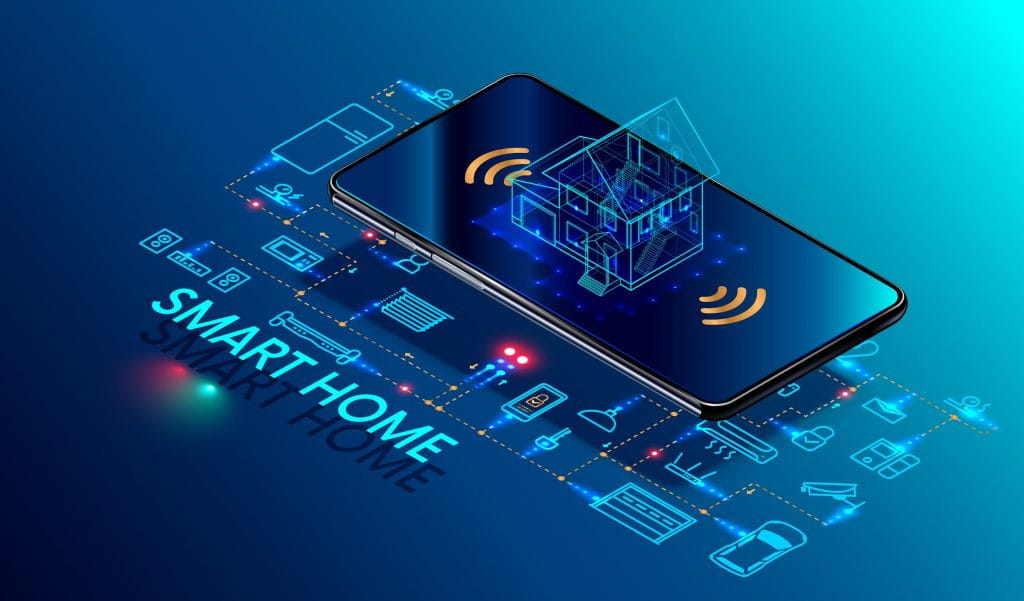Simple and intuitive, just a click away thanks to advanced and easily installable technologies, home heating allows you to monitor energy consumption, optimising costs and benefits. Here is how it works, improving efficiency and comfort.
How does the home automation system work?
A home automation system involves connecting the systems and devices inside a residence to control hubs. This allows for comprehensive programming of these systems, either through an application or voice commands.
There are three types of home automation systems:
- centralised, where each device depends on a central unit;
- distributed, in which each device operates autonomously;
- mixed, meaning it can use both wireless and wired technology, i.e. wires.
The ultimate goal is to ensure intelligent management of the systems, which is why it is referred to as a smart home. Home automation includes:
- video surveillance, for monitoring security cameras connected to your smartphone, interacting in real time;
- systems for detecting gas leaks, fires, and floods, which notify the user at any time and alert security and emergency services;
- electric windows, for raising or lowering curtains and blinds or adjusting shutters based on wind and sunlight.
- lighting systems, which recognize when it is time to turn lights on or off and adjust brightness.
Last but not least, a home automation system is also integrated with the heating system to regulate the indoor temperature, maintaining the desired comfort and achieving significant energy savings.
Users can operate it remotely with simple and immediate actions on their touchscreen devices, analysing data provided by multimedia channels.
What is the most affordable heating system?
As summer comes to an end, we all have doubts and questions about the best heating system to save on bills.
There are several alternatives to consider, taking into account the options available to individual users, which depend on various factors, including autonomous or centralised systems and the budget for potential investments.
- For example, following the fluctuations in the international gas market, some may opt for a gas boiler and solar panels. Using a renewable resource like sunlight reduces the need for gas, although it is not entirely eliminated. Especially during the winter season, gas remains essential for the boiler to produce hot domestic water.
- Alternatively, you can consider installing an electric boiler, which, like a gas one, provides heating and hot water. It reduces CO2 consumption, making it less environmentally impactful. However, electricity prices are subject to fluctuations that could lead to increased final costs.
- Condensing boilers are an evolution of traditional gas boilers and reduce fuel consumption. They are designed to fully utilise residual heat in exhaust gases. At the same time, their use is expected to decrease due to EU regulations aimed at installing new, more eco-friendly heat generators.
- Among these are heat pumps, which require significantly less fossil fuel, favouring renewable sources. However, they still have considerable costs and may be less attractive.
On the other hand, home automation is a key factor when it comes to energy efficiency, beyond the home heating system.
Smart heating tools can include intelligent thermostats.
A smart thermostat allows you to precisely set and measure the temperature of the surrounding spaces, even remotely. The algorithms it operates with also monitor humidity levels and air quality.
It is compatible with both boilers and heat pumps. Just follow the installation instructions to complete the application process and start harnessing its capabilities, from setting the desired temperature to turning off the heating when you believe it is appropriate.

What is the most efficient type of heating system?
Other types of heating system include wood-burning stoves and biomass boilers.
The former are powered by pellets or wood and, in some cases, are hybrid.
A biomass boiler, on the other hand, operates with substances derived from organic materials of animal and plant origin.
They have in common the adoption of radiators to distribute heat. While it may be obvious for biomass boilers, it is less so for wood-burning stoves, whose heat distribution methods can differ: through air, using vents, or through water, which is transferred to radiators after being heated.
Radiators, in turn, are not excluded from the benefits brought by home automation. Like smart thermostats, smart thermostatic valves make it easy to control the temperature through a smartphone at any time.
Easily installable as replacements for traditional manual ones, smart thermostatic valves allow you to regulate the temperature in each room. This way, a radiator can be activated only when truly necessary, reducing energy waste.
This leads to a fully customizable multi-zone coverage. They are designed for the safety of children in the home and can detect when a window is open, automatically suspending radiator operation for half an hour.
The full integration of a home automation system, including voice-controlled home assistant systems, activates multiple operating modes.
- With a home/away mode, settings can be adjusted based on the user's location.
- In holiday mode, the system is set to an antifreeze temperature to lower consumption and avoid unpleasant surprises upon return from vacation. It alerts in case of boiler blockage.
- The eco mode helps reduce consumption and emissions by slightly anticipating the system shutdown compared to the set time periods.
How much does a home automation system cost?
The cost of a home automation system varies depending on the type of system. An average order of high-quality performance (composed of a kit of valves and a smart thermostat) typically ranges around 600 pounds.
People can access the allocated bonuses for home energy improvement to cover installation costs.
Investments that benefit both the home and the environment.










































